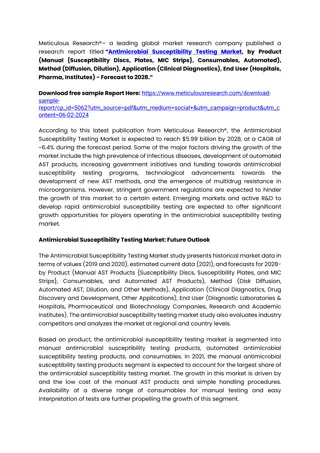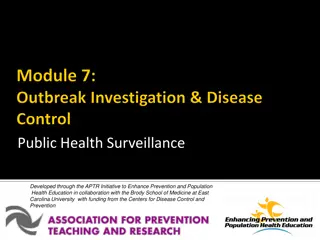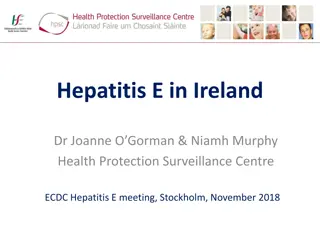Antimicrobial Susceptibility Testing Market
Antimicrobial susceptibility testing (AST) is a laboratory procedure to identify the right antimicrobial regimen against microbes. Thus, AST of the causative agent(s) is essential for the timely selection of appropriate antimicrobial therapy.
2 views • 3 slides
Overview of WHONET: A Powerful Tool for Antimicrobial Resistance Surveillance
WHONET is a free software used worldwide for managing and analyzing microbiology laboratory data, with a focus on antimicrobial resistance. It offers features like %RIS analysis, MDR tracking, and outbreak detection, benefiting various sectors including healthcare, research, and policy-making. BacLi
7 views • 14 slides
Injury Surveillance in Scotland: Importance and Implementation Overview
Scotland's Public Health body, Public Health Scotland, leads efforts in injury surveillance to prolong healthy life, prevent disease, and promote health. Long-term investment in prevention involves various sectors. Injury surveillance is crucial as it helps manage and prevent injuries, with coded da
4 views • 24 slides
Utilizing Audits for Antimicrobial Stewardship in General Practice
The importance of audits in antimicrobial stewardship is highlighted in this informative content covering topics like why audit and feedback are crucial, sources of prescribing data, available audit tools, practical tips, and a case study showcasing the positive impact of audits in UTI management. T
10 views • 40 slides
Antimicrobial Coatings Market: Exploring Sustainable Approaches to Microbial Con
The Antimicrobial Coatings Market is projected to reach $12.41 billion by 2031, at a CAGR of 10.8% from 2024 to 2031. The antimicrobial coatings help to keep surfaces pathogen-free by obstructing the growth of fungi, bacteria, and other parasites. Antimicrobial coatings provide long-lasting protecti
3 views • 4 slides
Antimicrobial Susceptibility Testing Market
Government initiatives for combating multidrug resistance are expected to boost the need for antimicrobial susceptibility testing products, thereby driving the growth of the global antimicrobial susceptibility testing market.
1 views • 2 slides
Trends in Gonococcal Resistance to Therapies in England and Wales Since 2011 Guideline Change
Antimicrobial resistance in Neisseria gonorrhoeae poses challenges for treatment. This study examines trends in ceftriaxone, azithromycin, and cefixime resistance since the 2011 guideline change in the UK. Data from the Gonococcal Resistance to Antimicrobial Surveillance Programme is analyzed to tra
0 views • 12 slides
Collaboration for Efficient COVID-19 Surveillance: NNDSS Case Notifications
Center for Surveillance, Epidemiology, and Laboratory Services is working with Michele Hoover's team to streamline the COVID-19 National Notifiable Diseases Surveillance System (NNDSS) for jurisdictional efficiencies. The timeline showcases the progression from the first CDC-confirmed case to the de
1 views • 20 slides
Food Preservation with Antimicrobial Preservatives
Food preservation with antimicrobial preservatives involves the use of chemical compounds to prevent or delay food spoilage. These compounds, either naturally present or added during processing, can kill microorganisms or control their growth in foods. Factors for evaluating the suitability of an an
6 views • 8 slides
Ideal Antimicrobial Agents and Antimicrobial Classification Overview
This lecture on general chemotherapy outlines the properties of ideal antimicrobial agents, emphasizing selective and effective activity, bactericidal action, non-toxicity, and more. It also covers the classification of antimicrobials based on chemical structure, including sulfonamides, diaminopyrim
6 views • 19 slides
Enhancing AFP Surveillance for Polio Eradication in East Africa
This presentation discusses the importance of Acute Flaccid Paralysis (AFP) surveillance in detecting poliomyelitis cases, with a focus on the National Stop Transmission of Polio Mission in Kasese District, Uganda. The goal is to eradicate poliovirus through strategies such as immunization campaigns
0 views • 12 slides
Overview of Epidemiological Cutoff Values (ECVs) in Antimicrobial Susceptibility Testing
Epidemiological Cutoff Values (ECVs) are crucial in determining antimicrobial susceptibility by distinguishing wild-type and non-wild-type microbial populations. ECVs are defined based on factors like minimal inhibitory concentration (MIC) and genetic variation, and are determined through specific m
0 views • 16 slides
Advances in Antimicrobial Drugs: Selective Toxicity and Classification
The development of antimicrobial drugs has significantly improved therapeutics by controlling infections and preventing complications. These drugs target invading microorganisms using selective toxicity, sparing host cells. Antimicrobial drugs are classified based on site, mechanism of action, and c
0 views • 30 slides
Enhancing Livestock Health Through Early Diagnostics and Targeted Antimicrobial Use
Utilizing early diagnostics in livestock for targeted antimicrobial administration is essential for effective disease management and reducing antimicrobial resistance. This approach aids in timely treatment, facilitates monitoring of animal health status, and supports preventive measures against eme
0 views • 10 slides
Role of Rapid Diagnostic Test for Measles in Global Surveillance
Laboratory-based surveillance is crucial for monitoring and controlling measles outbreaks. The development of new tools like rapid diagnostic tests (RDTs) for measles diagnosis can revolutionize surveillance efforts. Challenges in introducing new diagnostics are discussed, along with the importance
0 views • 30 slides
Understanding Antimicrobial Stewardship in Healthcare
Exploring the critical aspects of antimicrobial stewardship, including the reasons for antibiotic resistance, considerations for prescribing antibiotics, stewardship checklists, and the role of toolkits in promoting responsible antibiotic use to combat resistance. The importance of monitoring, docum
0 views • 20 slides
ECDC Point Prevalence Survey of Healthcare-associated Infections and Antimicrobial Use in European Acute Care Hospitals 2016-2017 Protocol v5.3 Forms
This protocol outlines the data collection form for the ECDC Point Prevalence Survey focusing on healthcare-associated infections and antimicrobial use in European acute care hospitals during 2016-2017. The detailed form covers various aspects such as hospital information, infection control measures
0 views • 8 slides
Global Antimicrobial Resistance Surveillance Market
The Global Antimicrobial Resistance Surveillance Market Size is anticipated to exceed USD 9.92 Billion by 2032, Growing at a CAGR of 5.8% from 2022 to 2032.\n
1 views • 5 slides
Harnessing Syndromic Surveillance Systems for Climate-Related Outcomes
Utilizing syndromic surveillance systems can provide valuable insights into the impact of climate change on health outcomes. This document aims to guide users on identifying outcomes, creating case definitions, combining data sources, and engaging with partners for effective climate and health surve
1 views • 28 slides
Comprehensive Overview of Hospital-Acquired Infection Surveillance System
Surveillance systems like HAI surveillance play a crucial role in monitoring and managing hospital-acquired infections (HAIs) by providing baseline rates, comparing data, and identifying problem areas. This system covers various types of infections such as CAUTI, CLABSI, VAE, and SSI, with specific
0 views • 20 slides
Enhancing Infection Surveillance in Long-Term Care Facilities
Explore the importance of surveillance, new definitions, implementation strategies, and outcomes in long-term care settings. Understand why surveillance is essential, how it is performed, population assessment, various surveillance approaches, and selection criteria for processes and outcomes.
0 views • 50 slides
Post Market Surveillance Procedures in Indonesia
Post-market surveillance of medical devices in Indonesia is overseen by the Surveillance Directorate of Medical Device and Household Health Supplies. Manufacturers must adhere to ASEAN guidelines and report adverse events through online systems. The country has specific regulations and requirements
0 views • 10 slides
Texas Influenza Surveillance Overview
In this overview, we delve into the details of influenza surveillance in Texas, covering various aspects such as flu testing, notifiable conditions, and the 2022-2023 flu season review. The information provided includes surveillance structures, reporting requirements, and the vital role of testing i
0 views • 17 slides
Understanding Antimicrobial Stewardship: Key Concepts and Importance
Explore the critical aspects of Antimicrobial Stewardship, including its definition, historical background, and the impact of antimicrobial resistance. Learn about the basics, such as the relationship between antimicrobial use and resistance patterns, as well as the importance of optimizing antimicr
0 views • 61 slides
Optimised Live/Dead Fluorescence Spectrometry for Antimicrobial Susceptibility Testing
This study focuses on the optimisation of live/dead fluorescence spectrometry for rapid antimicrobial susceptibility testing. The research uses fluorescent dyes to distinguish between live and dead cells, providing a potential method for quick antimicrobial resistance diagnostics. The experiment inv
0 views • 16 slides
Understanding Surveillance in Biodiversity Conservation
Surveillance plays a crucial role in biodiversity conservation by aiding in the early detection of new incursions and invasive species. It helps in limiting the spread of threats, identifying priorities for action, and assessing prevention system effectiveness through passive and active surveillance
0 views • 24 slides
Complexities of Antimicrobial Resistance in Farm Animals and Public Health
The epidemiology of antimicrobial resistance is multifaceted, involving various sectors such as aquaculture, soil, wildlife, human-animal interfaces, and more. The case study on ceftiofur resistance in chickens highlights the impact of antibiotic use on resistance levels in both animals and humans.
0 views • 4 slides
Phytochemical Screening and Antimicrobial Assessment of Mimosa pudica
This study explores the antimicrobial potential of Mimosa pudica extracts through phytochemical screening. Researchers investigated the leaves' antimicrobial characteristics and screened for phytochemical compositions to understand their effects on various microorganisms. The methodology involved sa
0 views • 18 slides
Understanding Public Health Surveillance for Population Health
Public Health Surveillance is a vital process for systematically collecting, analyzing, and interpreting health data to inform public health practices. This crucial initiative, developed through the APTR in collaboration with the Brody School of Medicine at East Carolina University, focuses on enhan
0 views • 40 slides
Hepatitis E Surveillance and Notifications in Ireland
The surveillance and notification of Hepatitis E cases in Ireland have been detailed, including the introduction of universal blood donor screening, notifiable disease status, and enhanced surveillance measures. The data shows trends in notifications, blood donor screening results, clinical cases, a
0 views • 13 slides
Challenges in Prescribing the Right Antimicrobial Agents
Prescribing the appropriate antimicrobial medication can be a daunting task due to various factors. In this case discussion, the patient is on multiple medications for different conditions, making it essential to carefully consider the choice of antimicrobial. Factors such as drug interactions, pati
0 views • 30 slides
Rally Against Mass Surveillance - StopWatching.Us Event Summary
Edward Snowden's revelations exposed government surveillance on citizens, sparking a rally against mass surveillance on October 26, 2013. The ACLU supports Snowden as a whistleblower, while NSA officials criticize him. The event highlights concerns over privacy, government overreach, and the collect
0 views • 18 slides
Enhancing Influenza Surveillance in Texas: Strategies and Goals
Emilio Gonzales presents a comprehensive plan for advancing influenza surveillance in Texas, focusing on considerations, goals for the upcoming flu season, and strategies to increase participation in surveillance programs. The plan includes enhancing respiratory disease surveillance, expanding senti
0 views • 15 slides
Industry and Occupation Surveillance Data Modernization Initiative
The Center for Surveillance, Epidemiology, and Laboratory Services is spearheading the NNDSS Modernization Initiative to capture industry and occupation surveillance data. The initiative includes a new industry and occupation message mapping guide template and the demonstration of the NIOSH Industry
0 views • 32 slides
Congressional Authority for National Security Surveillance under FISA
The Foreign Intelligence Surveillance Act (FISA) was passed in 1978 in response to abuses outlined in the Church Report. The Foreign Intelligence Surveillance Court (FISC) oversees FISA applications, with the ability for government appeal through the Foreign Intelligence Surveillance Court of Review
0 views • 82 slides
Insights into Healthcare-Associated Infections and Antimicrobial Use in Acute Care Settings
This report presents findings from a Point Prevalence Survey (PPS) on Healthcare-Associated Infections (HAI) and Antimicrobial Use (AMU) in acute care, highlighting the prevalence rates, distribution of infections, changes in infection rates, and patterns of antimicrobial consumption across European
0 views • 17 slides
Understanding Surveillance: Risks and Implications
Explore the concept of surveillance, its impact on society, and the rise of monitoring devices. Delve into discussions on the effectiveness of surveillance in deterring crime and privacy concerns raised by experts. Understand new words related to surveillance and key vocabulary terms in this thought
0 views • 11 slides
Surveillance Technology Policy and Data Governance 2022 Review
The Surveillance Technology Policy and Data Governance 2022 Review outlines past decisions on various surveillance technologies, public comments, recommendations sent to the Mayor, and updates on the Automatic License Plate Reader (ALPR) technology and other monitoring systems in the City of Syracus
0 views • 18 slides
Methods of Surveillance by Romanian Securitate in the Late 80s
Explore the various surveillance methods employed by the Romanian Securitate in the late 80s to monitor and control writers, including general and priority informational surveillance, individual surveillance files, and the dimensions of the secret archive. Learn about the measures taken by the Secur
0 views • 11 slides
Managing Catheter-Related Bloodstream Infections in Vascular Access
Reduce and prevent catheter-related bloodstream infections in vascular access by addressing extraluminal infection sources and implementing strategies outlined in national drivers such as the NHS Long Term Plan and the Antimicrobial Resistance Action Plan. Recognize the importance of tackling antimi
0 views • 25 slides







































